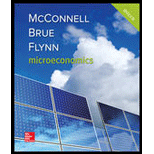
Sub part (a):
To determine: The flow of income.
Sub part (a):
Explanation of Solution
The construction of school forces the government to boost is expenses in the market by increasing business revenues. Resource owners of the school construction have a raise in income. These resources need to be side tracked from private sector. Taxes might have to increase to construct the high school.
In case, the economy is facing an
Concept Introduction
Circular flow: It is a way of representing the flow of money between the two main groups in society - producers (firms) and consumers (households). This flow is a part of the fundamental process for satisfying human wants.
Sub part (b):
To determine: The flow of income and impact of tax.
Sub part (b):
Explanation of Solution
It reduces the financial resources transfer from the businesses to the government. Then the business tax reduces and thus, the business owners will get a bigger percent of the income. These companies use the amplified profits to acquire capital commodities and labor. The weakening of the commercial income tax forces the government to reduce spending, and corporate spending increases the causing resource reallocation.
In case, the economy is facing unemployment and no reduction in government expenses, we see an increased spending if the companies increase their expenses on capital commodities. The distribution effect will have a dependency in knowing if the profits are going straight to people with a higher income or are these being spent for the assets and employees of the organization.
Sub part (c)
The impact over the resource reallocation of the economy.
Sub part (c)
Explanation of Solution
This will cause an increase in commodities and services to people from the government or this can be termed as net taxes that are being reduced, which is the same to a raise in transfer payments. This is the income’s redistribution in support of the people who are not wealthy. Resources to be paid by the government will be going up as additional teachers need to be employed and salaried.
This will need the resource reallocation from the private sector to the public sector by reducing the unemployment rate. In this case, there will be an upward pressure on prices to an extent if this is a transfer payment program and the production will not increase.
Sub part (d):
The impact over the resource reallocation of the economy.
Sub part (d):
Explanation of Solution
This will cause an increase in net taxes paid by business. As the business will see this as an increase in costs, it will bring down its
The households will reduce their demand for utilization of commodities and services from companies as they have a low income. So the net household taxes that the government receives will decrease. The distribution of income will be away from profits toward the other three categories to the extent that the total tax revenues increase.
There will be a slight increase in the allocation of resources from the private sector to the public sector. Resources will also be allocated towards pollution control equipment. As the supply has reduced due to the increase in costs to business, unemployment and thus, the prices will increase.
Want to see more full solutions like this?
- Critically analyse the five (5) characteristics of Ubuntu and provide examples of how they apply to the National Health Insurance (NHI) in South Africa.arrow_forwardCritically analyse the five (5) characteristics of Ubuntu and provide examples of how they apply to the National Health Insurance (NHI) in South Africa.arrow_forwardOutline the nine (9) consumer rights as specified in the Consumer Rights Act in South Africa.arrow_forward
- In what ways could you show the attractiveness of Philippines in the form of videos/campaigns to foreign investors? Cite 10 examples.arrow_forwardExplain the following terms and provide an example for each term: • Corruption • Fraud • Briberyarrow_forwardIn what ways could you show the attractiveness of a country in the form of videos/campaigns?arrow_forward
 Principles of MicroeconomicsEconomicsISBN:9781305156050Author:N. Gregory MankiwPublisher:Cengage Learning
Principles of MicroeconomicsEconomicsISBN:9781305156050Author:N. Gregory MankiwPublisher:Cengage Learning Principles of Economics 2eEconomicsISBN:9781947172364Author:Steven A. Greenlaw; David ShapiroPublisher:OpenStax
Principles of Economics 2eEconomicsISBN:9781947172364Author:Steven A. Greenlaw; David ShapiroPublisher:OpenStax Principles of Macroeconomics (MindTap Course List)EconomicsISBN:9781305971509Author:N. Gregory MankiwPublisher:Cengage Learning
Principles of Macroeconomics (MindTap Course List)EconomicsISBN:9781305971509Author:N. Gregory MankiwPublisher:Cengage Learning Principles of Economics (MindTap Course List)EconomicsISBN:9781305585126Author:N. Gregory MankiwPublisher:Cengage Learning
Principles of Economics (MindTap Course List)EconomicsISBN:9781305585126Author:N. Gregory MankiwPublisher:Cengage Learning Principles of Microeconomics (MindTap Course List)EconomicsISBN:9781305971493Author:N. Gregory MankiwPublisher:Cengage Learning
Principles of Microeconomics (MindTap Course List)EconomicsISBN:9781305971493Author:N. Gregory MankiwPublisher:Cengage Learning





